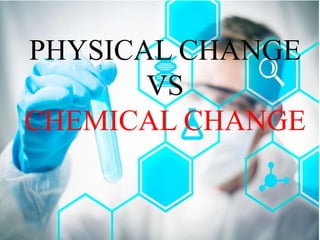JESIEL DEMO.pptx
- 2. OBJECTIV ES: Understand the difference between physical changes and chemical change. Tell evidence of physical changes and chemical change. Categorize changes as physical or chemical, and show examples of each.
- 3. WHAT IS PHYSICAL CHANGE?
- 4. PHYSICAL CHANGE No new substance is created. Involves a change in phase, size and shape. No alteration in its composition.
- 5. EXAMPLE CRUSHING A CAN BOILING WATER CHOPPING WOOD BREAKING OF GLASS
- 6. WHAT IS CHEMICAL CHANGE?
- 7. CHEMICAL CHANGE New substance is created. Evidence include formation of precipitate, production of heat and light and change in color
- 8. EXAMPLE BURNING OF WOOD RUSTING OF IRON DIGESTION
- 10. PHYSICAL CHANGE
- 11. PHYSICAL CHANGE
- 12. CHEMICAL CHANGE
- 13. MELTING OF CANDLE PHYSICAL CHANGE
- 14. CUTTING OF PAPER PHYSICAL CHANGE
- 17. AS A NOTREDAMEI ANS HOW DOES CHANGE AFFECT YOUR LIFE?
- 19. TEST I. Essay (express your idea) 1. What is the difference between physical and chemical change? (5pts. Expand your idea)
- 20. TEST II. Classify the following examples as physical or chemical changes. a) A puddle of water evaporates. b) Lighting the gas in a bunsen burner. c) Lighting a match. d) Steam condensing on a mirror. e) Melting a gold nugget to make a gold bar. f) Dynamite exploding. g) Water freezes to make ice cubes. h) Ice cream melting.
